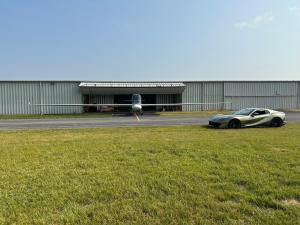
My dad flew P-47s in WWII. He also gave me my first airplane ride in a Piper Tri-Pacer when I was very young and he introduced me to u-control in the 1950s, all which sparked my interest in aviation and flying model aircraft.
I joined the USAF in 1965 and was an electronic warfare repairman for the four years of active duty. On Guam Island, I saw guys flying R/C near my barracks and was quite intrigued. After active duty, I went to work for National Flight Services, an FBO at Toledo Express Airport, doing avionics maintenance and installation. It was during that time that I got into R/C.
After five years at National Flight, I went to work for the Air National Guard at KTOL for 28 years. I was in electronic warfare maintenance for the first 18 years and was promoted to Chief Master Sergeant for my last 10 years.
In 1971, I built an R/C ugly stick and joined the Toledo Weak Signals R/C club. During my time in the club, I got on the Weak Signals Exposition Committee in 1975, running Communications for 11 years. In 1986, I became a Co-Director. I put a total of 46 years on the committee, 35 as Co-Director until COVID hit which ended our show. In 2004, the Academy of Model Aeronautics conferred upon me the title of FELLOW “For countless years of service to aeromodelling through his efforts in the Toledo Expo.”
I started to fly R/C gliders in 1973, and in that year's NATS, I placed 5th overall which got me a spot in the World Championships. In 1974, I flew in what then was called the Internats with a 13-foot wingspan Astro-Jeff sailplane, and placed 2nd in the world.
I also flew Cross Country sailplanes in the NATS with a three-man team in two different years, winning both years in 2010 and 2012. The 2010 year, we flew a closed course of around 6.5 miles as I remember, with a total of 69.9 miles in over 5 hours, on a single launch. On the team also was Skip Miller as the primary pilot and Mark Gellart as the spotter. I was the driver and had to focus on driving, not flying, but also where to land when getting low, and where lift might be when we decided to land. Often, I saved the flight because when we stopped to land, I took the glider controls and found lift that I had been looking for signs of while driving, to allow us to climb and continue on course. I’d then give the controls back to Skip and we would all jump back in the car to continue the flight.
In 2015, I got a ride in a Stemme S10, self-launching glider with 75-foot wingspan. That sunk the hook, and in 2016, I spent the summer driving twice a week to a glider school in Ionia, Michigan, changing my flying focus from R/C to full size. I took delivery of a new Stemme S12 in early 2018. The S12 has an 82-foot wingspan with a 53:1 glide ratio! It seats two, side by side.
I got almost 200 flying hours total when I decided to sell the Stemme and go back to R/C flying.


